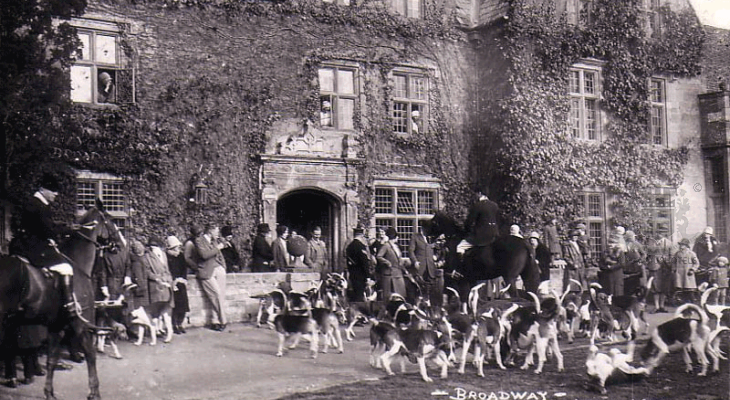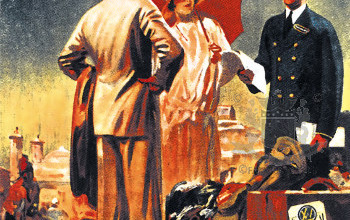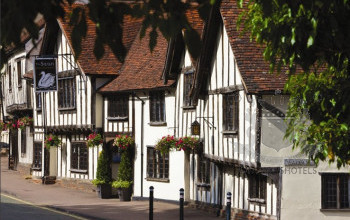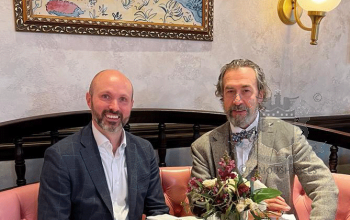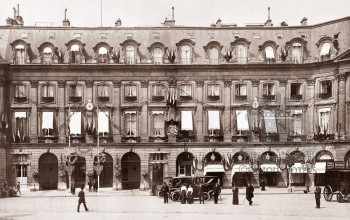Meeting Cromwell - A Piece of English History
( words)
By Adrian Mourby*
The Lygon Arms in Broadway looks exactly how you’d expect an old Cotswold inn to appear. Stone fireplaces, heavy wooden doors, uneven flagstones, mullioned windows and creaking floorboards denote a history that goes back to medieval times when this hostelry was known as The White Hart Inn. The white hart (a mature stag) was the personal symbol of King Richard II (1367-1400) although the first written record of the hotel only dates back to 1532, the year before Elizabeth I came to the throne.
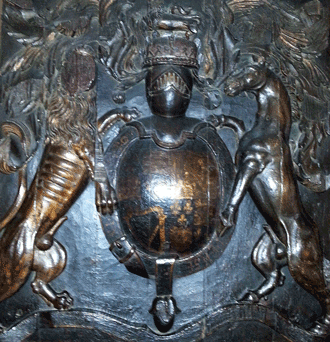 Today the hotel’s appearance is Tudor, reflecting the prosperity of Broadway as a staging post on the route between Wales, Worcester and London in Elizabethan times. However the inn leaps dramatically into the history books in Stuart times, during the English Civil War that pitted Queen Elizabeth’s cousin Charles I (his coat of arms to the left) against the forces of the English Parliament.
Today the hotel’s appearance is Tudor, reflecting the prosperity of Broadway as a staging post on the route between Wales, Worcester and London in Elizabethan times. However the inn leaps dramatically into the history books in Stuart times, during the English Civil War that pitted Queen Elizabeth’s cousin Charles I (his coat of arms to the left) against the forces of the English Parliament.
 Oliver Cromwell, who led the Parliamentary army, slept at the White Hart Inn in 1652 the night before the Battle of Worcester that finally destroyed the royalist cause. His bedroom is known as the Cromwell Room with a copy of his famous "warts and all" portrait next to a huge seventeenth-century fireplace. The room is kept for private dining and meetings today so my wife and I slept instead in the Charles I Suite which has the king's coat of arms over one of its fireplaces. Significantly the face of the royal lion has been hacked off. Nobody knows when but we do know that the doomed king did have a meeting with his supporters at the White Hart Inn sometime before 1649, the year of his execution. (The Battle of Worcester pitted Cromwell against his son, the exiled Charles II). The suite, which is just over the front door, has two spacious rooms and a bathroom with eccentric plumbing. It is the perfect place to spend a long winter weekend. The only drawback is that its two fireplaces are not in use.
Oliver Cromwell, who led the Parliamentary army, slept at the White Hart Inn in 1652 the night before the Battle of Worcester that finally destroyed the royalist cause. His bedroom is known as the Cromwell Room with a copy of his famous "warts and all" portrait next to a huge seventeenth-century fireplace. The room is kept for private dining and meetings today so my wife and I slept instead in the Charles I Suite which has the king's coat of arms over one of its fireplaces. Significantly the face of the royal lion has been hacked off. Nobody knows when but we do know that the doomed king did have a meeting with his supporters at the White Hart Inn sometime before 1649, the year of his execution. (The Battle of Worcester pitted Cromwell against his son, the exiled Charles II). The suite, which is just over the front door, has two spacious rooms and a bathroom with eccentric plumbing. It is the perfect place to spend a long winter weekend. The only drawback is that its two fireplaces are not in use.
However there are plenty of fireplaces on the ground floor where you can curl up with a drink in the evening. If you like the aroma of woodsmoke (and I do) this is the hotel for you.
That evening we dined at Luke's Brasserie which is one of the hotel's two dining rooms. By pleasing contrast, one of the oldest of Britain's hotels has the UK's youngest headchef designing its menu. Luke Thomas (born 1993) is a national culinary phenomenon and I was very taken with his scallops with mussels in curry sauce.
That night we slept in a surprisingly small fourposter bed (but then in Elizabethan times people slept sitting up). The ceiling beams creaked overhead as other guests came back from their dinners. There was a palpable sense of spending the night in a piece of English history.
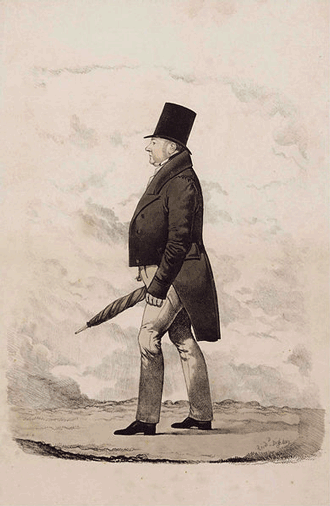
The next morning I found out how the White Hart Inn became the Lygon Arms. In 1820 General Henry Beauchamp Lygon (above), who had served with the Duke of Wellington during the Peninsula War, bought a Cotswold estate that included the White Hart. In 1841 when he was MP for West Worcestershire he either installed his butler as manager or his butler left his service to become the manager of the White Hart. Accounts vary. Either way Mr Charles Drury, the former butler, renamed his inn after General Lygon (picture).

Plenty of comfy places where you can curl up with a drink in the evening.
Henry Beauchamp Lygon had a very successful life. He received colonelship of the tenth Royal Hussars in 1843 and in 1853 entered the House of Lords as the fourth Earl Beauchamp but today his best memorial is this lovely, historic hotel.
The hotel: //thehotelcollection.co.uk/hotels/the-lygon-arms-hotel-cotswolds
*Adrian Mourby, contributing editor of famoushotels.org, won the "2013 Best Travel Article Award" by the Italian Tourism Board.

